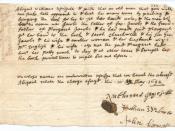Arthur Miller set his play "The Crucible" in the town of Salem, Massachusetts, in the year 1692. The story revolves around a farmer John Proctor and his community, devastated by allegations of witchcraft. The play begins with a group of young girls being discovered to have been dancing in the forest. Fearing the consequences of what they did, the girls begin to lie about their actions. When one of the girls falls ill, accusation of witchery becomes their escape from suspicion. This coincidence only helps exceed the villagers' beliefs of supernatural possession. Abigail Williams, the prime motivator behind these series of events, takes this opportunity to accuse Elizabeth, the wife of John Proctor, of practicing witchcraft. In so doing, she hopes to be able not only to effect vengeance on Proctor, who had earlier rejected her after an affair, but to regain him by eliminating her competition. Lies build upon lies as the chain of events escalates and results in many deaths.
When John Proctor tries to save his wife and friends, he is forced to question his own values and beliefs and is made to choose between the purity of his name and the value of his life.
Miller saw in history a parallel sequence of events: a mass hysteria that gripped people and destroyed the social fabric of their community. The cruel persecution of minorities and the interference of the state in the individual's conscience became the key concerns of Miller's criticism of this people's actions and beliefs. Miller relates the actions of the people in 1692 to present day by stating that when one rises above the villainy displayed, one can only pity them all, just as we shall be pitied someday.
Miller portrays these Puritans as a selfish group of people who can claim witchery...


